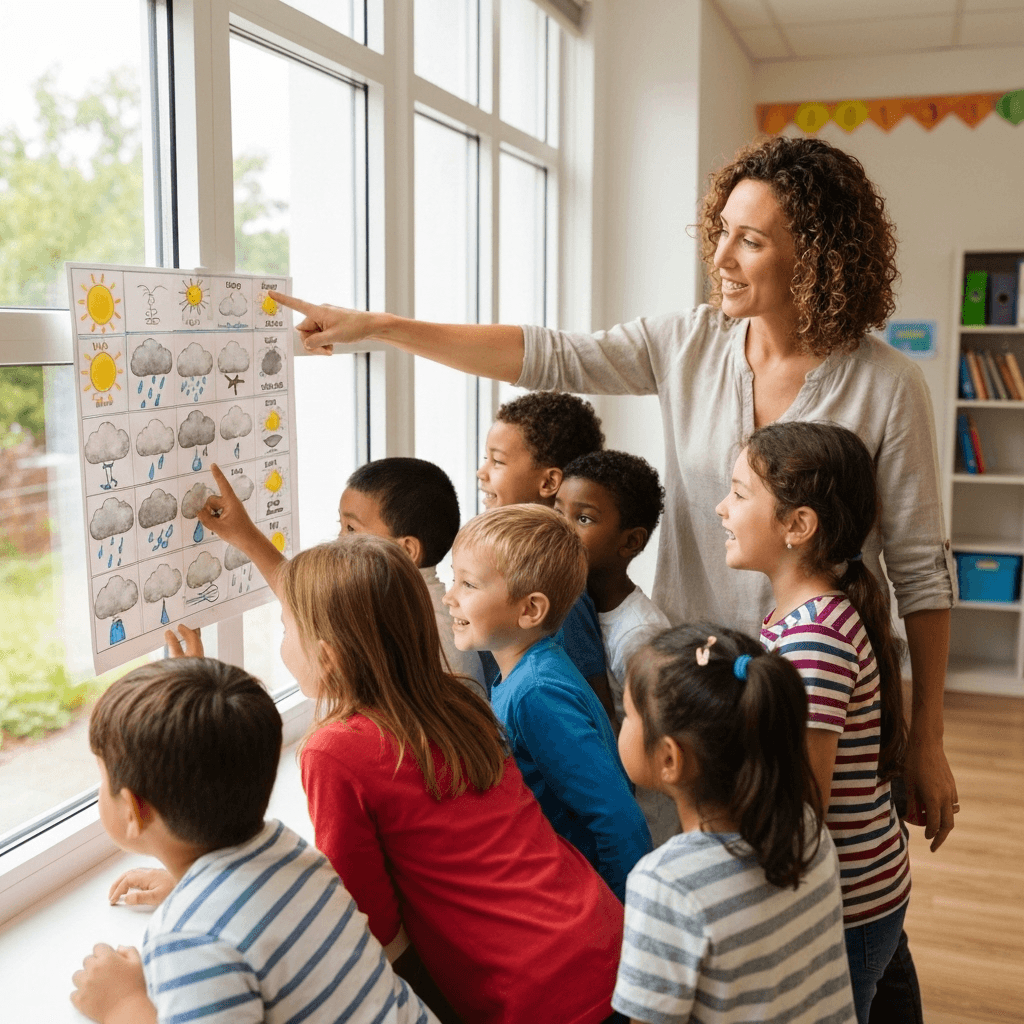Week 2: What Different Kinds of Weather Do We Have?
Weekly Focus
Children explore different types of weather and seasonal patterns through observation, hands-on activities, and creative expression. They learn about wet and dry seasons and create weather patterns.

Week at a Glance
Daily themes for Week 2
- MondayRead Aloud & Weather Types
- TuesdayWeather Chart & Data Collection
- WednesdayVideo & Nature Walk
- ThursdayItsy Bitsy Spider & Crafts
- FridaySeasons & Weather Patterns
Teacher Tip
Learning Objectives
- Identify and describe different weather types (sunny, rainy, cloudy, windy, stormy)
- Understand seasonal patterns in their region (wet season, dry season)
- Collect and interpret weather data using charts and graphs
- Create simple repeating patterns using weather symbols
- Express weather concepts through art, movement, and creative activities
- Develop weather vocabulary and descriptive language
Key Vocabulary
Materials Needed
- Weather chart and symbol cards
- "What Will the Weather Be Like Today?" book/video
- Art supplies for weather crafts and paintings
- Musical instruments for weather sounds
- Weather wheel craft materials
- Rain stick materials (paper towel rolls, foil, rice)
- Pattern cards with weather symbols
- Weather-appropriate clothing for fashion show
Daily Plans
Monday: Introduction to Weather Types
Focus Question
What different kinds of weather do we have? What seasons do we have?
Suggested Books
- "What Will the Weather Be Like Today?" by Paul Rogers
- "Weather Words and What They Mean" by Gail Gibbons
- "All About Weather" by Martha Brockenbrough
Read Aloud Introduction
Begin with the weekly question and invite children to share their favorite types of weather. Show the book cover and ask children to predict what the story will be about based on title and illustrations. Review key weather vocabulary words through matching activities.
Teacher Tip: Pause during reading to point out illustrations and ask comprehension questions about weather types and seasonal changes.
Interactive Story Reading
Read "What Will the Weather Be Like Today?" with interactive elements. When reading about sunny weather, have children stand and do sunshine dances. For rainy weather, make rain sounds with bodies. For windy weather, pretend to blow things away or act like items being blown.
Weather Discussion & Sharing
After the story, ask children to name different types of weather from the story and express their feelings about each type. Have children draw their favorite part of the story and share what they learned. Go outside to describe today's weather based on story information.
Extension: Create a class chart of different weather types mentioned in the story and add children's own weather experiences.
Art Activity
Children draw and share their favorite weather type from the story. Encourage them to include details about what people wear, what activities they do, and how the environment looks in that weather.

Closing Circle
Share weather drawings and discuss the variety of weather types. Begin establishing the weekly weather observation routine and introduce the concept of weather patterns.
Reflection Questions:
- What new weather words did you learn today?
- Which weather type from the story was most interesting?
- How does weather change throughout the year?
Featured Activities
Weather Station Rotations
Students rotate through four weather stations (sun, rain, clouds, wind) to explore weather characteristics through hands-on activities and props, building understanding of different weather types.
Materials:
Weather station props, sunglasses, umbrellas, cotton balls, fans, weather symbols
Weather Fashion Show
Students model weather-appropriate clothing and accessories while explaining how different weather conditions affect what we wear, connecting weather to daily life decisions.
Materials:
Weather clothing, accessories, runway space, weather cards
Weather Pattern Creation
Students create and extend simple repeating patterns using weather symbols, developing mathematical thinking while reinforcing weather vocabulary and concepts.
Materials:
Weather symbol cards, pattern strips, crayons, weather chart
Weather Dance & Movement
Students express different weather types through creative movement and dance, using props and instruments to enhance the sensory experience of weather concepts.
Materials:
Musical instruments, scarves, weather props, open space
Resources
Books
- "What Will the Weather Be Like Today?" by Paul Rogers
- "The Itsy-Bitsy Spider" traditional song
- "All About the Weather" video
- "Weather Words and What They Mean" by Gail Gibbons
- "Maisy's Wonderful Weather Book" by Lucy Cousins
Printables
- Weekly weather chart template
- Weather symbol cards and pictures
- Weather pattern activity sheets
- Weather wheel craft template
- Seasonal sorting activity sheets
Home Connection
- Family weather tracking activity
- Seasonal clothing sorting game
- Weather vocabulary practice cards
- Weather safety discussion guide
- Weather pattern creation activities
